 Imitations of Roman Coin Types AD 330-337
Imitations of Roman Coin Types AD 330-337
GLORIA EXERCITVS, VRBS ROMA, and CONSTANTINOPOLIS
Under Constantine (AD 307-337) some types of copper coins were commonly imitated. (The imitation to the right is small at 13 mm. It is discussed below.) This page begins with five official prototypes which have links to their imitations. The very common GLORIA EXERCITVS imitations are discussed on this page and the other types are on their own pages.
1) "Two Victories" (on its own page, here) holding shield inscribed "VOT/PR" over low column, VICTORIAE LAETAE PRINC PERP (c. 318-320)
All AE types were replaced c. 330 by three new types
2) Imperial portrait/GLORIA EXERCITVS (this page, below)
2A) two soldiers and two standards (330-335), later decreased in size to
2B) two soldiers and one standard (335-340)
3) VRBS ROMA (here) with helmeted bust of Roma left/wolf and twins left
4) CONSTANTINOPOLIS (here) with helmeted bust of Constantinople left/Victory left, holding palm branch, with foot on prow
5) Other types before 340
6) Types from 340-347.
This page begins with five official examples of types commonly imitated:
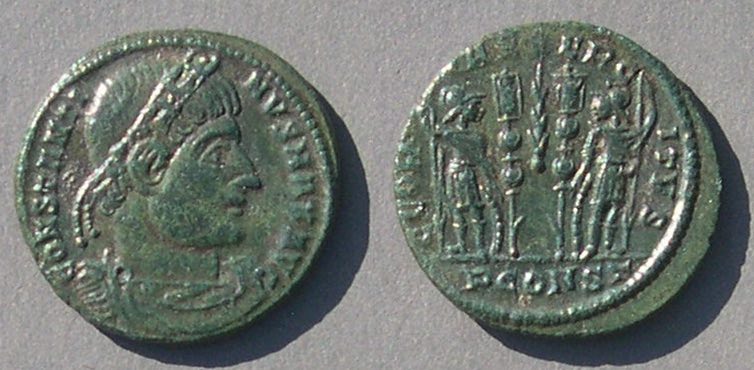 Type 1A: GLORIA EXERCITVS/two standards (struck 330-335). This piece: 18 mm (larger than most). 2.86 grams. Constantine/PCONST in exergue, Arelate mint (it had been renamed "Constantina" in honor of Constantine II, which explains the "CONS")
Type 1A: GLORIA EXERCITVS/two standards (struck 330-335). This piece: 18 mm (larger than most). 2.86 grams. Constantine/PCONST in exergue, Arelate mint (it had been renamed "Constantina" in honor of Constantine II, which explains the "CONS")
Imitations of this type are discussed below.
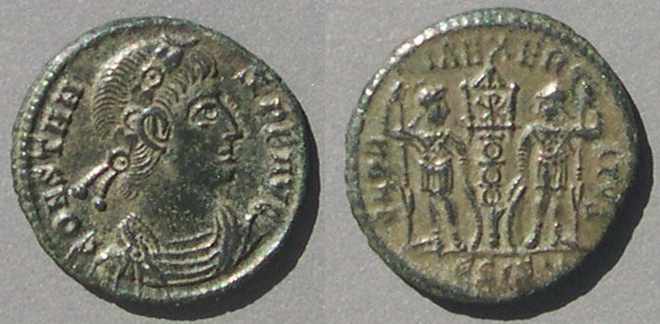 Type 1B: GLORIA EXERCITVS/one standard (struck 335-340). This piece: 16 mm. 1.76 grams. Constans/one standard with chi-rho, in exergue ESIS, Siscia mint.
Type 1B: GLORIA EXERCITVS/one standard (struck 335-340). This piece: 16 mm. 1.76 grams. Constans/one standard with chi-rho, in exergue ESIS, Siscia mint.
All images are to the same scale. This coin looks smaller than the previous 2-standard coin because it is smaller.
Imitations of this type are discussed below.
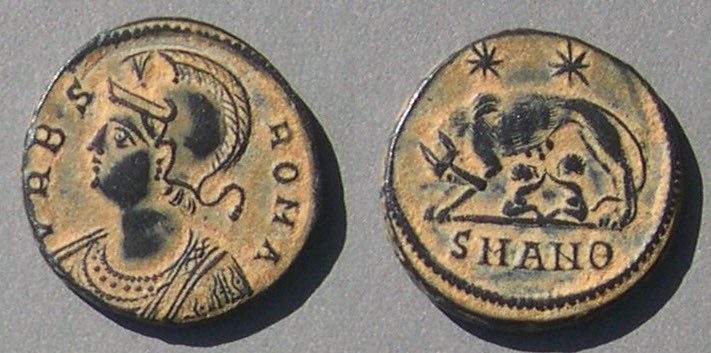 Type 2: VRBS ROMA/wolf and twins. This piece: 17 mm. 2.92 grams.
Type 2: VRBS ROMA/wolf and twins. This piece: 17 mm. 2.92 grams.
In exergue SMANΘ, Antioch mint.
Imitations of this type are discussed on their own page.
Type 3: CONSTANTINOPOLIS/Victory left, holding sceptre in right and resting left on shield, her right foot on prow. This piece: 18 mm. 2.27 grams. In exergue: BSIS, Siscia mint.
Imitations of this type are discussed on their own page.
These types were extensively imitated, especially in Britain.
 Type 4:
Type 4:
Two Victories holding a shield inscribed VOT/PR over an altar, VICTORIAE LAETAE PRINC PERP around.
This comes with several obverse bust types.
This piece: 19-18 mm. 2.77 grams.
Obverse bust right in a close-fitting helmet with a long, low, crest.
ASIS* in exergue.
RIC Siscia 47, struck 318
Type 1A was originally issued for Constantine and his Caesars Constantine II and Constantius II, and, beginning in 333, for the newly created Caesar Constans, and then in 335 for the new Caesar Delmatius. Shortly thereafter, in 335 the module was reduced and the two standards replaced with only one standard (Type 1B). Most coins of Delmatius are of the one-standard variety. Similarly, coins of Constans with two standards are scarce, in strong contrast to his very common one-standard coins. The type continued after Constantine's death in 337. At that time, Constantine II assumed the titles that Constantine had had, so his coins as Augustus (until his death in 340), which are scarce, can have the same legend as coins of Constantine I (and are fairly often confused with coins of Constantine I).
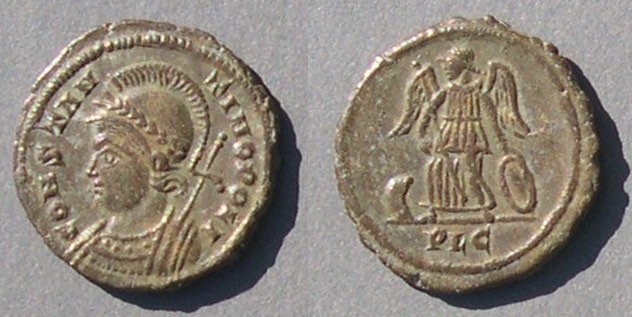 15 mm, 1.66 grams, 6:00 die axis.
15 mm, 1.66 grams, 6:00 die axis.
Official? Imitation?
This piece: CONSTANTINOPOLI [sic]. This legend without the terminal "S" is normal at Constantinople, Heraclea, Nicomedia, and Cyzicus, but not elsewhere. It is not expected at Lugdunum.
At Lugdunum, but not elsewhere, some rare official examples were issued in very good style with distinctly smaller module. Modules smaller than normal at other mints are usually a sure sign of an imitation (See RIC Lyons 246 note), The line between "imitation" and "official" is not necessarily clear. In the next pages you will see a few more coins that could fall on either side of the line, but may be classified as imitations simply because they are "too small" to be official.
All images on these pages are to the same scale -- small images mean the coin is small.
This page continues with imitations of GLORIA EXERCITVS with two standards first and then with one standard.
When legible, the GLORIA EXERCITVS types of "Constantine" found in Britain are of Constantine II, not Constantine I. (I suppose there may be exceptions.) This suggests they were produced after Constantine's death in 337. A few examples have the legend of Constantius II. John Kent, the author of RIC VIII on the coins of the sons of Constantine, thinks that very few official AE coins were minted from 340 to 347, i.e. after the death of Constantine II and before the reform of 348. This dearth of coinage might have been filled by these unofficial issues. I suggest they were struck (most are struck, not cast) between 340 and 346. The types struck 340-347 before the FEL TEMP REPARATIO types are rarely imitated.
GLORIA EXERCITVS/two standards
 14 mm. 6:00.
14 mm. 6:00.
Constantine II.
Unusually small coins in good style and execution appear with the Lugdunum mintmark (A CONSTANTINOPOLIS example is the previous piece). But is is hard to believe that one mint, and not others, issued smaller official coins.
CONSTANTINVS IVN NOC
/GLOR-IAEXER [CITVS]
/• PLG
This coin gives every evidence of being official, except for its small size.
Prototype: RIC Lyons p. 137 ff. The mintmark is of 330-331, which should be when the coins are largest of the series. This piece is almost enough to make one think "half" denomination pieces were issued, but it does not make sense to issue different denominations that are so similar. Therefore, I am including this, with hesitation, as an imitation.
 16 mm. 12:00. Constantine II.
16 mm. 12:00. Constantine II.
The line between official and imitation can be hard to draw. The irregular termination of the obverse legend puts this one in the "imitation" category, but the style and execution are otherwise pretty close to official.
CONSTANTINVS IVNOC [sic]
/GLOR - [IA EXERCITVS]
star above standards, SCON[ST} in exergue
Prototype: RIC Arles 346, page 271.
Bought at CICF, Chicago, 1991
 14-13 mm. 6:00. 0.80 grams. Constantine II
14-13 mm. 6:00. 0.80 grams. Constantine II
Corroded and worn.
The good style and execution of some coins like this one has led people to postulate a denomination half the value of the usual. I doubt it. I think this is just a very well done imitation.
CONSTANTINVSVNNC
/GLORIA EXERCITVS, two standards
/in exergue: PLG
RIC has no such obverse legend, but see Lyons p. 140 for the mintmark and p. 7 for weights.
Bought in Montana (!), 1977.
 15-14 mm. 12:00. Constantine II
15-14 mm. 12:00. Constantine II
Bold strike, well-engraved portrait.
CONSTANTINVS IVN NOC
/crude letters IIOP-IAEXER ....
From Vecchi, 1996.
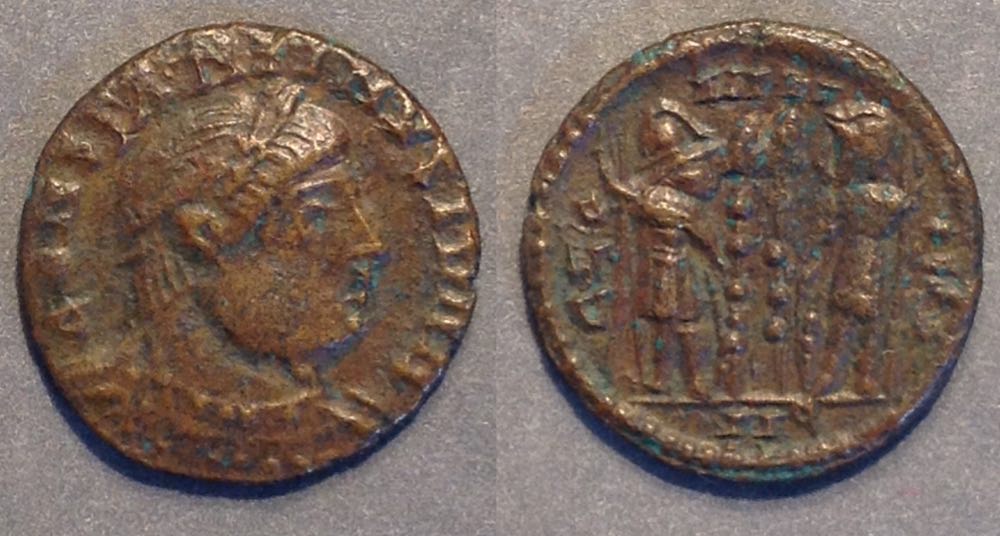 15 mm. 12:00. 1.39 grams. Constantine II
15 mm. 12:00. 1.39 grams. Constantine II
Bold and nearly full flan.
CONSTANTINVS IVIIII legend terminates in nearly vertical strokes
/GLO IIII IIII, legend begins acceptably, but terminates in nearly vertical strokes
/in exergue, I I
From Empire at SIN, LA, 1985.
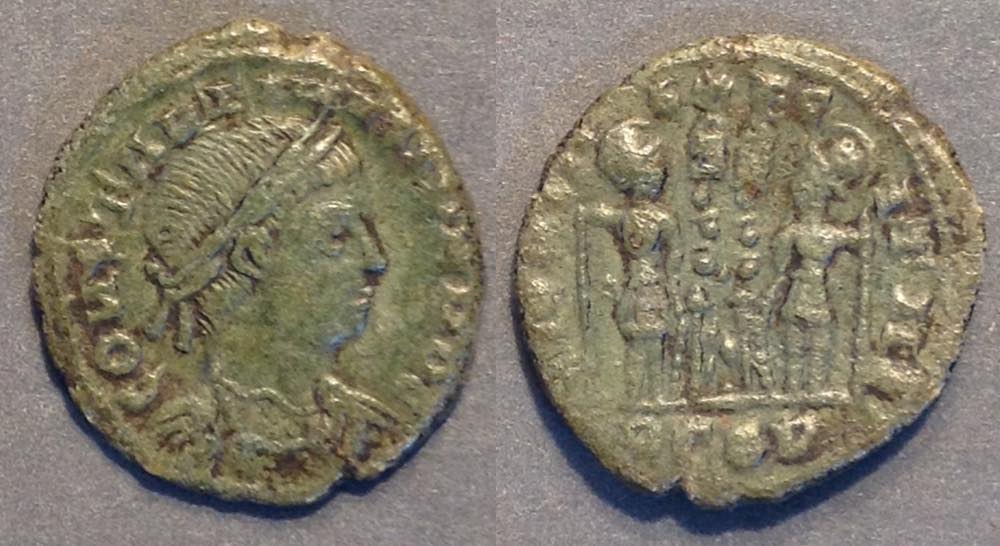
16-15 mm. 6:00. Constantine II
Blundered legends. Some letter-like forms.
COHSTAHTIHVS IVH HOC [something vaguely like this]
/[GLORIA] EXEC - ITVS
/in exergue: something vaguley like DCOD, which is unrecognizable
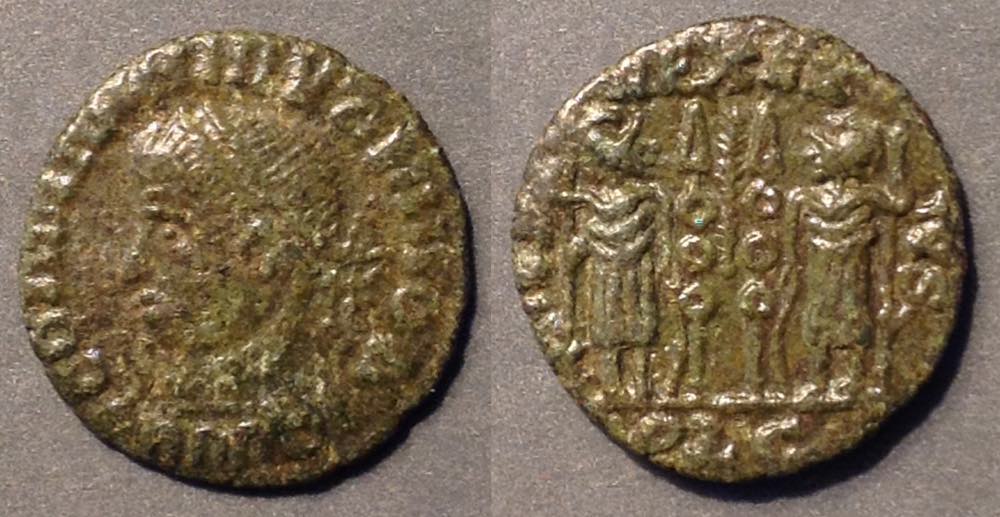 15 mm. 1.19 grams.
15 mm. 1.19 grams.
Constantine II
Bust left.
After beginning "CO", the obverse legend is mostly I's.
/irregular sized reverse letters, [....]A EXER-IVS
/in exergue: PLG
Next are some of the better(!) ones selected from many hundreds at coin fairs in England:

12-10 mm.
1) crude 2) mintmark there, but illegible 3) remarkably crude 4) legible, but weakly struck
5) Constantine II, mintmark TR[P] 6) Remarkably fine portrait. Mintmark TP[.] 7) Constantius II, mintmark SPLC
One Standard
 13 mm. 6:00.
13 mm. 6:00.
CONSTANI - VS PF AVG (Constantine II was Augustus from 337-340)
Garbled reverse legend, two soldiers and one standard.
In exergue; TPS<crescent>, in imitation of a mintmark of Trier
Prototype of Constantinus II, RIC VIII Trier 96, page 144. Bastien ANSMN 1985, plate 41, 12-14.
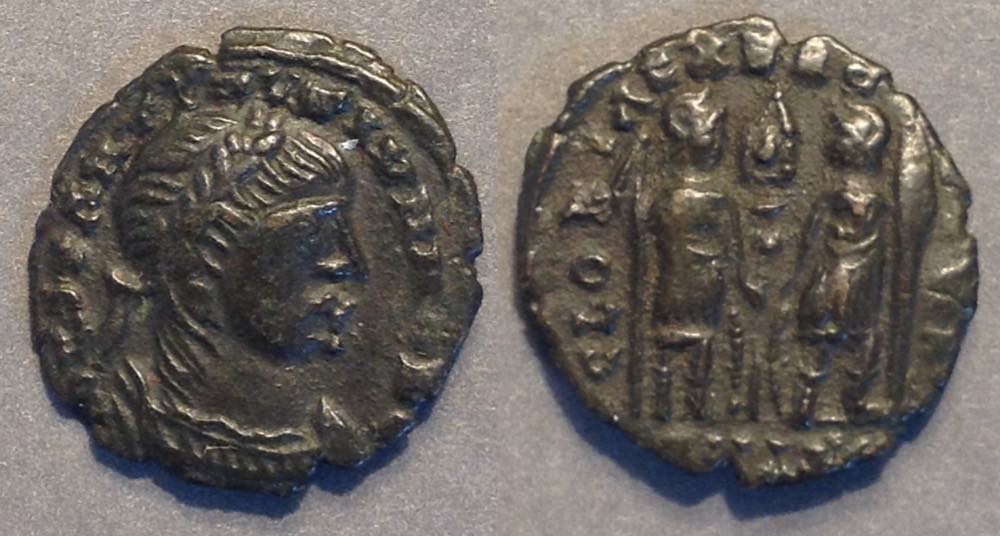 17-16 mm. 6:00. Constantine II
17-16 mm. 6:00. Constantine II
Crude lettering, but legend decyperable
CONSTANTINNVS IVN NOB C
/GLORIA EXERC[ITVS]
Mintmark obscure, but perhaps with SM..
From Vecchi, 1996.
(I don't think this one is from England becuase the mintmark and surface are wrong for English finds, although I got it from Vecchi in London.)
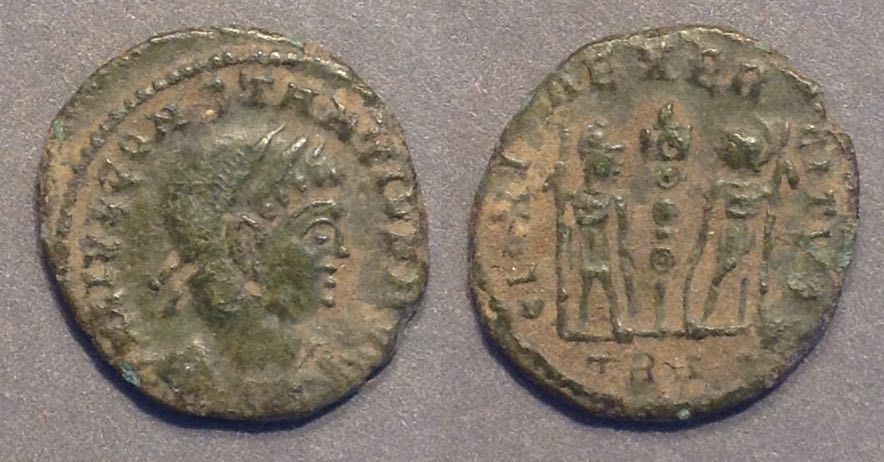 15-14 mm. 1.31 grams.
15-14 mm. 1.31 grams.
Constantius IIExcellent style.
FL IVL CONSTANTIVS NC
/GLORI-EXER-CITVS
/in exergue: TRP (?)
This coin is too small to be official, but nothing in the style betrays it.
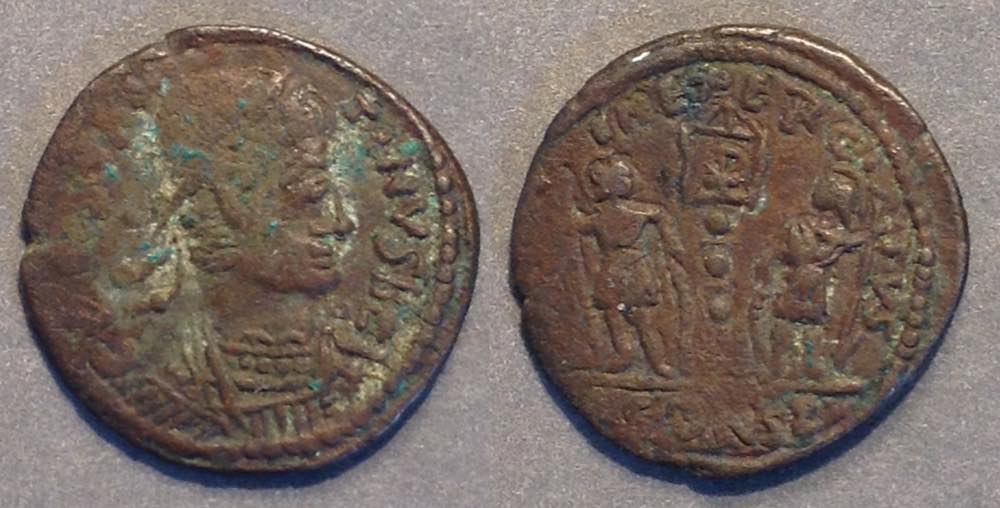 15 mm. 1.71 grams.
15 mm. 1.71 grams.
Constantine II
Crude style bust, but some letters legible.
CONSTAN-TINVS B C [sic]
/[....]IA EXERCI-TVS, standard with chi-rho
/in exergue: [ ]CONSI
Mintmark of Arles, the mint that has official chi-rho's prior to the death of Constantine with the mintmark PCONST.
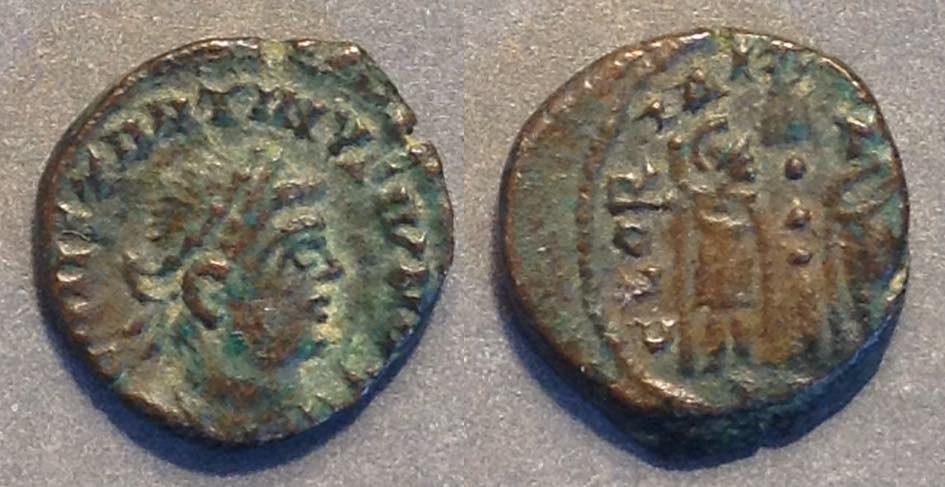 10 mm. 1.08 grams. Constantine II. Tiny, with outstanding lettering.
10 mm. 1.08 grams. Constantine II. Tiny, with outstanding lettering.
A piece is remarkable for its small and detailed dies. Rarely is such a small flan matched by correspondingly small dies done so well. The size assures it is an imitation -- why did the engraver do such a fine job on the obverse legend?
CONSTANTINVS IVN ...
/GLORIA [EXERCITVS]
mintmark not visible.
From Berk, 1984.
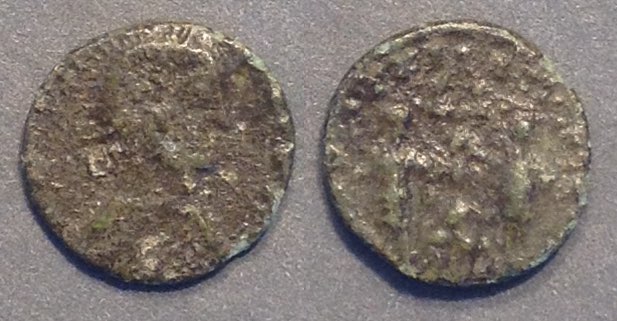 10 mm. 0.55 grams.
10 mm. 0.55 grams.
Terrible condition! Nevertheless, there are many worse.
 10 mm. 0.62 grams.
10 mm. 0.62 grams.
Very crude.
Is this an imitation of a two soldiers and two standards type?
If not, what is the prototype?
Next are six more bought in England. (Two are repeats.)
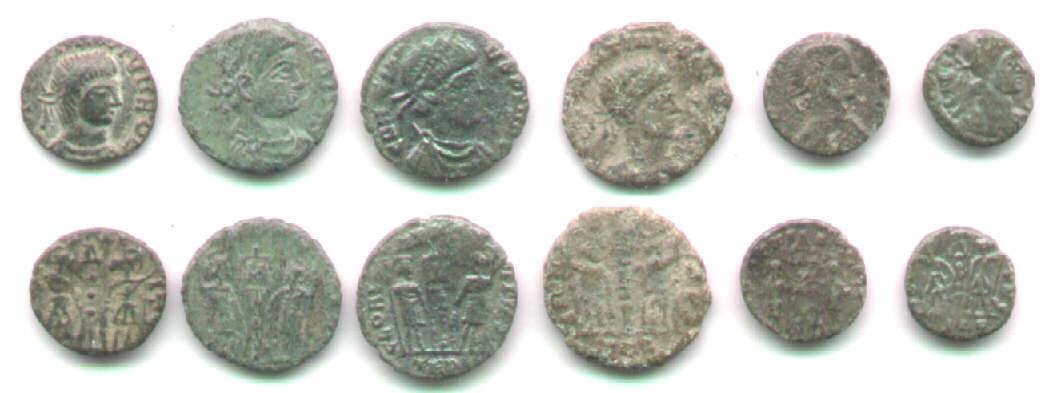
13-9 mm.
1) High relief, blundered letters 2) small flan for dies 3) some good letters, mintmark TRP
4) some good letters, PLG mintmark 5) 10 mm 6) 9 mm, maybe [P]LG mintmark
Ugly imitations like these, and worse, are found in huge numbers in England.
You have just finished the first page on Constantinian imitations from 318-348.
Go to the page on other, earlier, Constantinian imitations.
Continue with the page on VRBS ROMA imitations.
Skip to the page on CONSTANTINOPLIS imitations.
Skip to the page on imitations from AD 340-347.
Go to the page on Two Victories imitations.
Jump to the page on FEL TEMP REPARATO imitations.
Return to the main Table of Contents page on Roman imitations.
 Imitations of Roman Coin Types AD 330-337
Imitations of Roman Coin Types AD 330-337 Type 1A: GLORIA EXERCITVS/two standards (struck 330-335). This piece: 18 mm (larger than most). 2.86 grams. Constantine/PCONST in exergue, Arelate mint (it had been renamed "Constantina" in honor of Constantine II, which explains the "CONS")
Type 1A: GLORIA EXERCITVS/two standards (struck 330-335). This piece: 18 mm (larger than most). 2.86 grams. Constantine/PCONST in exergue, Arelate mint (it had been renamed "Constantina" in honor of Constantine II, which explains the "CONS")



 15 mm, 1.66 grams, 6:00 die axis.
15 mm, 1.66 grams, 6:00 die axis. 14 mm. 6:00.
14 mm. 6:00. 16 mm. 12:00. Constantine II.
16 mm. 12:00. Constantine II.
 15-14 mm. 12:00. Constantine II
15-14 mm. 12:00. Constantine II 15 mm. 12:00. 1.39 grams. Constantine II
15 mm. 12:00. 1.39 grams. Constantine II
 15 mm. 1.19 grams.
15 mm. 1.19 grams.
 17-16 mm. 6:00. Constantine II
17-16 mm. 6:00. Constantine II 15-14 mm. 1.31 grams.
15-14 mm. 1.31 grams. 15 mm. 1.71 grams.
15 mm. 1.71 grams.  10 mm. 1.08 grams. Constantine II. Tiny, with outstanding lettering.
10 mm. 1.08 grams. Constantine II. Tiny, with outstanding lettering. 10 mm. 0.55 grams.
10 mm. 0.55 grams. 10 mm. 0.62 grams.
10 mm. 0.62 grams.